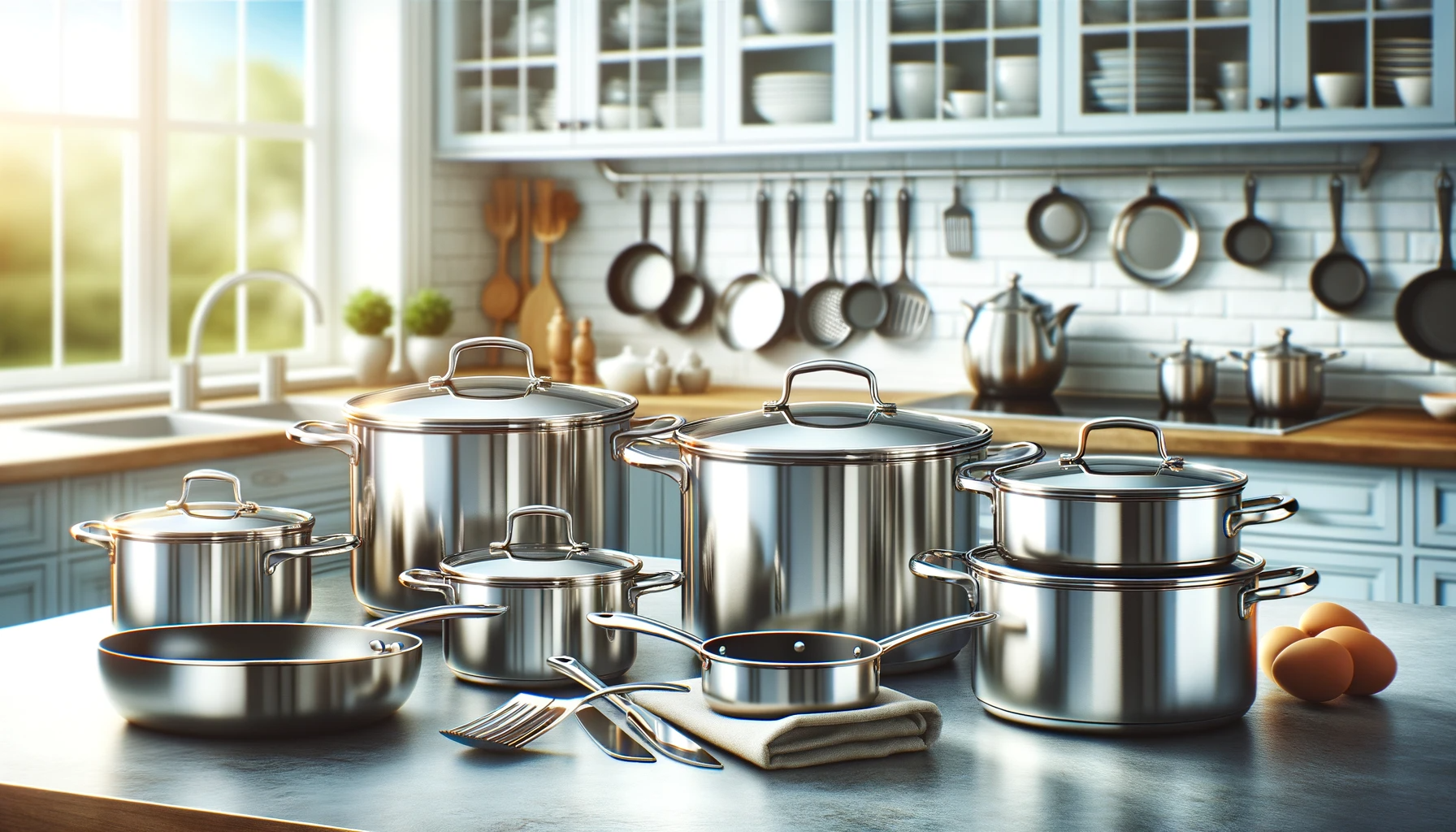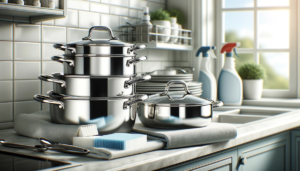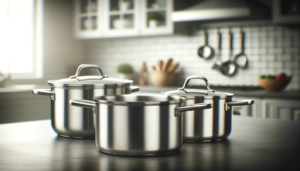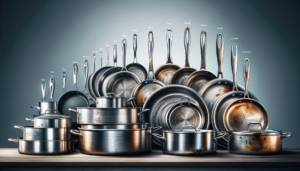Saladmaster’s surgical stainless steel cookware makes a beautiful, high-performing addition to any kitchen.
However, like any fine cookware, these pots and pans require special care and cleaning to maintain their flawless finishes over decades of use.
Understanding the proper techniques and tools to clean both the interiors and exteriors of Saladmaster stainless steel can help homeowners keep them looking like new after thousands of meals.
Let’s dive in to see exactly how to care for these investment pieces.
How to Clean Saladmaster Surgical Stainless Steel Cookware?

The best way to clean Saladmaster surgical stainless steel pots and pans is by handwashing them with mild dish soap or detergent and soft, non-abrasive scrubbing tools.
Use baking soda paste on exteriors periodically.
Stubborn cooked-on residue can be removed with a hot vinegar-water soak followed by gentle scrubbing.
Proper finishing includes thorough rinsing and immediate towel drying to prevent water spots.
Below we’ll explore the supplies needed for care as well as techniques for cleaning interiors, exteriors, stuck-on mess, and maintaining the factory finish over decades of use.
Supplies Needed

To properly clean Saladmaster surgical stainless steel cookware, you will need to gather a few supplies.
Dish soap or another mild detergent can help cut through grease and food residue on the interior surfaces of the pots and pans.
Opt for a brand formulated for sensitive skin or dishes.
You will also require a soft sponge or dishcloth to gently scrub the cookware.
The soft texture helps protect the finish while removing stuck-on messes.
For hard-to-reach spots like corners and crevices, have a soft toothbrush on hand.
The small brush makes targeting tight areas easier.
Baking soda serves as a gentle, non-abrasive cleanser for the exteriors of the Saladmaster cookware.
Simply sprinkling some onto a damp sponge helps lift residue.
White vinegar can also be useful for dissolving stubborn cooked-on stains.
Fill cookware with equal parts vinegar and water and bring to a boil to naturally loosen debris.
Of course, you will need access to running water for rinsing.
Avoid letting pans and pots air dry to prevent water spots.
Instead, have clean soft towels ready to buff the exteriors dry.
Cleaning the Interior

Saladmaster interiors require frequent cleaning to maintain their surgical stainless steel finish.
Start by filling the cookware about halfway with hot water from the tap.
Water that is too hot can damage the metal over time, so use a moderate temperature.
Add a small squirt or spoonful of mild dish soap.
Liquid varieties spread easier to penetrate oil and grease.
Allow the water and soap solution to sit for 2-3 minutes so the heat and detergent can soften any cooked-on food.
Using your soft sponge or dishcloth, gently scrub the interior in circular motions.
Apply light pressure rather than an aggressive scouring to protect the surface.
If any bits refuse to budge, try using the soft-bristle toothbrush.
Carefully scrub at stuck spots for thirty seconds to one minute before checking progress.
Once the inside looks free of residue, empty the sudsy water and rinse well.
Run clean hot water over all areas, tilting to reach nooks.
Check corners and around rims for any lingering debris.
An immediate second wash helps eliminate soap film that can impart taste to foods during later cooking.
Avoid using harsh chemical rinses, as these can damage the special finish over time and reduce effectiveness.
After washing, place the still-damp item on a folded kitchen towel.
Allow any remaining moisture to evaporate naturally instead of towel drying the interior.
Residual dampness often appears as water marks or spots.
Proper air circulation speeds drying to maintain the immaculate finish.
Cleaning the Exterior

While Saladmaster interiors contact food frequently, the brand’s surgical stainless steel also graces durable, beautiful exteriors.
These outer surfaces deserve regular gentle cleaning and polishing to maintain their luster.
Every few uses, treat them to a baking soda paste scrub.
Simply sprinkle a liberal amount of baking soda onto a soft, damp sponge.
Lightly wet the sponge if the soda does not adhere in a textured layer.
Spread and rub the paste thoroughly over the visible surfaces, allowing it to penetrate and lift oil and fingerprints.
Let the paste sit for 2-3 minutes.
As it sets, the soda micro-abrasives will help gently clean without scratching.
After letting it set, rub the exterior in broad circular motions using your paste-coated sponge.
Apply even pressure for uniform results.
Concentrate on areas that see more handling during cooking and storage, like handles and rims.
These gather more oils from hands.
Rinse thoroughly when finished scrubbing, washing all traces of soda down the drain.
Avoid using extremely hot rinse water, as thermal shock can damage and discolor stainless steel over time.
Cool or lukewarm temperatures are preferred.
As a final step after rinsing, take a fresh soft lint-free towel and pat the cookware exterior dry.
Lingering moisture droplets can leave unsightly water spots that may require repeat scrubbing to remove.
Instead, carefully buff and wipe the surgical stainless steel finish to an even sheen.
Turn items as needed to access all sides.
Proper drying helps maintain beauty between deep cleanings.
Removing Stubborn Residue

Over time, Saladmaster stainless steel can develop stuck-on residue or stains from extended cooking sessions.
Foods with sugars, tomatoes, and milk are common culprits.
While baking soda paste removes general dirt, stripped pans may need help lifting years of grime or discoloration.
An easy non-toxic method relies on the acid in standard white vinegar.
Simply fill the cookware about 2/3 full with cool tap water, then pour in equal parts vinegar.
If using measuring cups, a 1:1 ratio works well.
Set filled cookware on the stove over high heat.
Allow the solution to reach a rolling boil, watching closely to avoid boil-overs.
As it heats, you may see bubbles and foam indicating the vinegar is penetrating and lifting stains.
Once vigorously boiling, turn off the heat but allow pans to remain sitting on grates for 15-30 minutes.
This gives the solution extra soak time to loosen stubborn cooked-on messes.
Avoid walking away for longer periods, as vinegar can etch stainless steel if left for over an hour.
When the soak time completes, don protective gloves if needed and empty the hot vinegar water into the sink.
Avoid pouring solutions onto counter surfaces, as vinegar can damage softer materials like laminates or limestone.
Use your soft sponge or cloth to gently scrub the warm interior.
Repeat as needed if any residue remains.
Rinse very thoroughly after scrubbing and check for streaks or soap scum.
Repeat the wash cycle if water still sheets or beads, indicating unseen residue.
Maintaining the Finish

Saladmaster prides themselves on surgical stainless steel cookware finishes that last a lifetime with proper care.
While durable, the interiors and exteriors still require gentle handling day to day.
This ensures their beauty and cooking performance over decades of regular use.
Avoid abrasive scouring pads, metal tools, or chemical cleaners around Saladmaster pots and pans.
These can micro-scratch surfaces to create sites for stains to gather and food to stick during cooking.
Soft sponges, cloths, and brushes better protect the finish.
Limiting abrasion also means hand washing cookware when possible.
While convenient, running Saladmaster items through harsh dishwasher cycles exposes them to blowing soil particles and chemical detergents daily.
These eat away at protective top layers over years of exposure.
Hand cleaning allows you to control water temperatures, scrubbing pressure, and rinsing thoroughness while being gentle on finishes.
If dishwashing is unavoidable, take care to load pots and pans securely.
Loose items bang against racks, damaging their own and neighboring surfaces.
Use low heat drying cycles instead of blasts of heat to gently dry utensils.
No matter how frequently it sees use, always rinse cookware immediately after washing and allow it to air dry.
Leftover debris like food scraps or soap scum dries in place if pots sit wet for hours.
This leaves rings, streaks and stains you must scrub off later.
However, soft towel drying avoids water marks from air evaporation.
By caring both for Saladmaster’s daily maintenance and long term preservation, its stainless steel cookware should serve your kitchen reliably for decades.
The key lies in consistent gentle handling to let this performance material keep performing.
Conclusion
Properly caring for Saladmaster cookware requires gentle, consistent cleaning and storage methods.
By using non-abrasive tools and cleaners, handwashing when possible, and throughly rinsing and drying after each use, these surgical stainless steel pieces can serve your kitchen reliably for decades to come.
Treat them with care, and let Saladmaster enhance your cooking for a lifetime.



